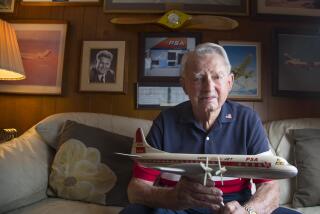USAir to Return a Few of PSA’s Famous Smiles
- Share via
USAir, which wiped the smiles off of Pacific Southwest Airlines’ jetliners after acquiring the San Diego-based airline in early 1988, is grinning once again.
USAir won’t be painting smiles on its own jet fleet, but the Washington-based airline is adding smiles to the noses of nine USAir Express propjets that provide commuter service in California, Arizona and Nevada, USAir spokesman Larry Pickett said Thursday.
PSA folklore credits the first smile to a mischievous maintenance man with a paint brush. But former PSA executives have maintained that smile evolved from a 1969 advertising campaign that eventually included the airline’s “Catch our Smile” slogan. By the mid-1980s, only United Air Line’s “Friendly Skies” slogan commanded more recognition among West Coast travelers than the PSA slogan and the smile.
USAir, however, retired the smile after “extensive marketing studies” indicated that the smile lost its power outside of PSA’s service territory. “A smiling plane going into La Guardia might not have the same marketing impact” as a smile-bedecked airliner landing at Los Angeles International, Pickett said.
USAir, which is facing increased competition in the Los Angeles-San Francisco corridor, believes that the copyrighted smile retains enough recognition among consumers to help boost market share for the USAir Express operation that Phoenix-based StatesWest Airlines has operated for USAir since July.
“USAir has been feeling increased (pressure) as far as our regional operations,” Pickett said. “But we’re still the major carrier in California with more flights than anybody else.” Pickett described the smile’s return as part of a “more energetic marketing approach” by USAir.
StatesWest, which has painted its aircraft to match USAir’s red, white and blue livery, is “very excited about having the smile,” said StatesWest founder, chairman and chief executive, Rudy R. Miller. “We’re building on a great recognition factor that PSA developed.”
Miller wanted to use the smile because, like the old PSA, USAir Express is a “fun-oriented West Coast customer service attitude.” StatesWest actively sought USAir’s approval to use the PSA smile, a registered trademark that is owned by USAir, Miller said.
The advertising world recalls the PSA smile “as an outstanding and fun” tool, according to Bob Kwait, an executive with Phillips Ramsey, a San Diego-based advertising agency. Kwait was uncertain, however, if the smile was powerful enough to help an airline other than PSA.
The PSA smile’s return generated smiles and a few quips from executives at Southwest Airlines, the Texas-based airline that has for years advertised itself as PSA’s rightful heir in the California market where PSA dominated because of its low fares, high frequencies and personalized service.
“We find it quite humorous that you can paint smiles on the outside,” Southwest Vice President Don Valentine said. “I always thought that smiles came from within.”
Valentine described PSA’s smile and the corresponding “Catch Our Smile” advertising campaign as “a classic success story.” But he cautioned that USAir Express’ advertising campaign would soon fade away unless the commuter airline offers the low fares, high frequencies and personal service that Californians now expect.
And, one former PSA executive noted that the smile’s marketing power might already have faded. “Having taken it off at the acquisition, (USAir) would seem to have lost the momentum,” the executive said.
More to Read
Inside the business of entertainment
The Wide Shot brings you news, analysis and insights on everything from streaming wars to production — and what it all means for the future.
You may occasionally receive promotional content from the Los Angeles Times.








